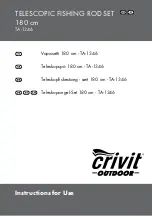
2-1
Chapter 2
Preparation
Preparation
The deadweight tester must be set up on a level, stable workbench or similar surface.
Level the tester using the four adjustable feet to the bubble level attached to the top plate.
Connection to External Pressure Supply
The connection port in the rear panel of the instrument is ¼ NPT. Pressure supply must
be both clean and dry — a compressed gas bottle (instrument quality nitrogen or air)
fitted with a pressure regulator is recommended. Factory (compressor) air lines should
only be used if a series of filters are fitted to ensure that the supply is clean and dry.
The external pressure supply must be regulated to either the maximum range of the
deadweight tester, or 10% above the maximum pressure required, whichever is the lower.
W
Warning
Great care must be taken when operating any pneumatic
deadweight tester, as any contamination present within the
system will result in degradation of performance, and eventual
IRREPARABLE DAMAGE to the PCUs.
Do not over-pressurize the deadweight tester.
To avoid damage to the instrument, the operator should ensure that any device under test
(DUT) is clean and dry before connecting it to the test port. If the DUT is of unknown
cleanliness, the Dirt/Moisture Trap, P5532, can be mounted to the test port of the
deadweight tester. This will prevent any dirt particles or moisture droplets present within
the DUT from passing into the deadweight tester system, (See Chapter 8, Ancillary
Equipment).
Connections
Fit the device under test (DUT) to the test port using the method described below:
W
Caution
Ensure that all devices are internally clean and free from
contamination before connecting to the tester.
Particle contamination can damage the sensitive piston
assemblies, valve seats and screw pump.
To avoid cross-contamination from other fluids, and protect the
system from particulates, we recommend the use of Liquid
Separator 5521M, (refer Chapter 9, Ancillary Equipment).
Summary of Contents for P3031
Page 6: ...P3031 P3032 Users Manual iv...
Page 8: ...P3031 P3032 Users Manual vi...
Page 18: ...P3031 P3032 Users Manual 2 6...
Page 22: ...P3031 P3032 Users Manual 4 2...
Page 30: ...P3031 P3032 Users Manual 5 8...
Page 32: ...P3031 P3032 Users Manual 6 2...
Page 34: ...P3031 P3032 Users Manual 7 2...













































